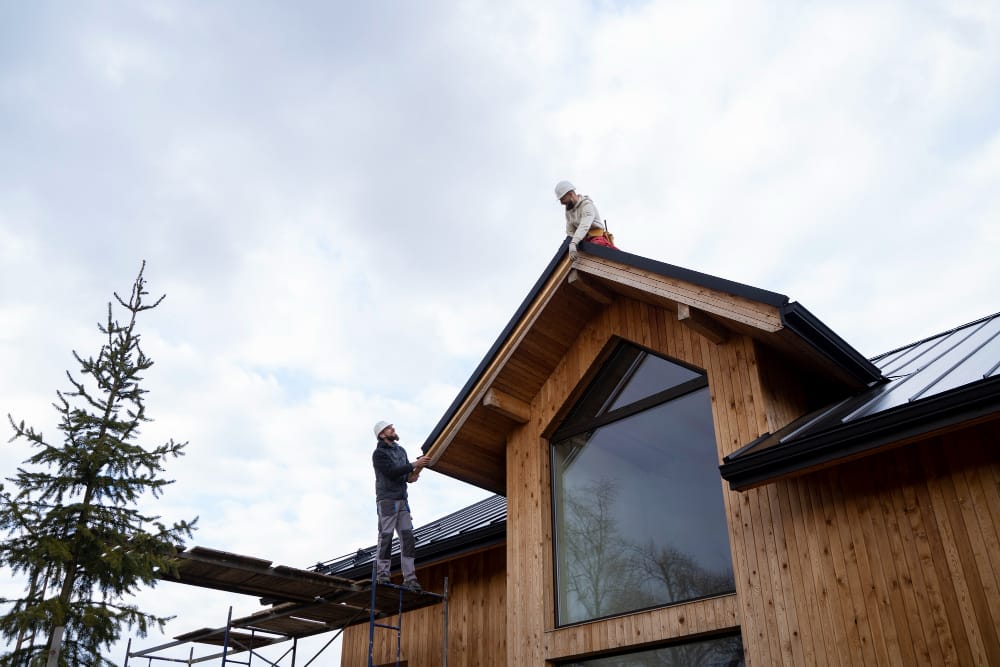If you’ve noticed missing shingles, water stains on your ceiling, or your roof simply looks worn out, you’re probably asking yourself whether it’s time for a replacement. Searching for the signs your roof needs to be replaced often comes at a stressful point—either because you’re already facing leaks and damage, or because you’re planning ahead before investing in a new roofing system.
Knowing what to look for and how long different roofing materials typically last can save you from unexpected repair costs, structural damage, and ongoing headaches. This article will guide you through the key signs of roof failure, the lifespan of common roofing materials, and practical tips to help extend the life of your roof.
Table of Contents:
- Why Your Roof Matters More Than You Think
- Signs Your Roof Needs to be Replaced
- Age and Lifespan of Roofing Materials
- How to Extend the Life of Your Roof
- Conclusion
Why Your Roof Matters More Than You Think
Your roof does far more than keep the rain out—it plays a critical role in protecting your entire home. A well-maintained roof shields your house from weather extremes, prevents water damage, and helps regulate indoor temperature, which directly impacts your energy bills. Beyond protection, your roof also affects curb appeal and overall property value; a damaged or aging roof can lower resale potential and raise red flags for buyers. Ignoring roofing problems doesn’t just risk leaks—it can compromise the structural integrity of your home and lead to costly interior repairs. That’s why staying on top of your roof’s condition is one of the smartest investments you can make in long-term home maintenance.
Signs Your Roof Needs to be Replaced
Not every roofing issue means you need a full replacement, but there are certain warning signs that indicate your roof may be nearing the end of its life. Catching these early can help you avoid bigger, more expensive problems later on. Some of the most common signs include:
- Missing, cracked, or curling shingles – Visible damage to shingles is often the first clue that your roof is wearing out.
- Frequent leaks or water stains indoors – If you’re seeing water spots on ceilings or walls, the roof’s protective barrier has likely been compromised.
- Sagging areas – A sagging roofline can signal structural damage underneath the surface.
- Moss, mold, or rot – Excessive growth on your roof can trap moisture and speed up deterioration.
- Granules in gutters – Asphalt shingles shed protective granules as they age. Finding a lot of them in your gutters is a sign of advanced wear.
- Daylight through the attic – If light is coming through roof boards in your attic, it’s only a matter of time before water will too.
If multiple signs are present, repairs may no longer be enough, and a full roof replacement is often the safer and more cost-effective solution.
Age and Lifespan of Roofing Materials
Even without visible damage, the age of your roof is a big factor in whether it needs to be replaced. Every roofing material has an expected lifespan, which can be shortened by harsh weather, poor installation, or lack of maintenance. On average:
- Asphalt shingles: 15–30 years (most common and budget-friendly).
- Wood shakes: 20–40 years (a natural look but requires more upkeep).
- Metal roofing: 40–70 years (durable and resistant to most weather).
- Clay or concrete tiles: 50–100 years (very long-lasting but heavy, requiring strong roof framing).
- Slate: 75–100+ years (premium option with exceptional durability, but the initial cost is very high).
If your roof is approaching the end of its expected lifespan, it’s wise to start planning for replacement before leaks and damage appear.
How to Extend the Life of Your Roof
While every roof eventually needs replacing, good care can maximize its lifespan and delay major expenses. Here are a few proven ways to keep your roof in better shape for longer:
- Schedule regular inspections – Have your roof checked by a professional at least once a year, or after major storms.
- Keep gutters clear – Blocked gutters can cause water to back up under shingles and damage the roof deck.
- Trim overhanging branches – Falling branches and constant shade can both harm shingles and encourage moss growth.
- Fix small problems quickly – Replacing a few damaged shingles or sealing minor leaks right away can prevent larger issues.
- Ensure proper ventilation – A well-ventilated attic reduces heat and moisture buildup, which can otherwise shorten roof life.
Taking these steps not only extends your roof’s performance but also helps protect the rest of your home from costly damage.
Conclusion
Knowing the early signs your roof needs to be replaced can make the difference between a manageable home project and a financial headache. Whether it’s visible damage like missing shingles, hidden problems such as leaks, or simply the age of your roof reaching its limit, acting before the situation escalates protects both your home and your wallet. The good news is that with the right knowledge and timely action, you can avoid surprise repairs, and preserve your home’s value.
If you’ve spotted any of these signs on your own roof, or if you simply want a professional assessment to ensure your home is protected, don’t hesitate to seek expert advice. Reach out to Ener-Spray today for a comprehensive evaluation, solution, and lasting protection you can count on.
